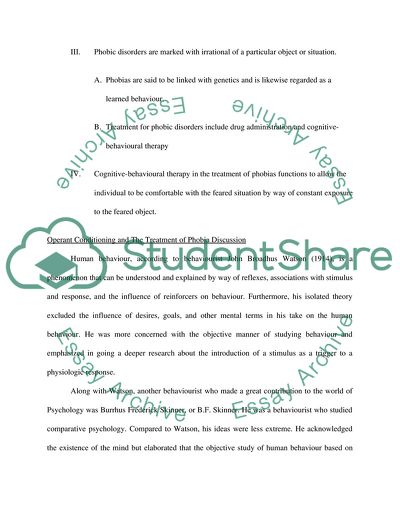Cite this document
(Outline and explain the Behaviourist concept of Operant Assignment Example | Topics and Well Written Essays - 1250 words, n.d.)
Outline and explain the Behaviourist concept of Operant Assignment Example | Topics and Well Written Essays - 1250 words. https://studentshare.org/psychology/1729113-outline-and-explain-the-behaviourist-concept-of-operant-conditioningexplain-how-the-treatment-of-operant-conditioning-could-be-used-by-therapists-treating-phobias
Outline and explain the Behaviourist concept of Operant Assignment Example | Topics and Well Written Essays - 1250 words. https://studentshare.org/psychology/1729113-outline-and-explain-the-behaviourist-concept-of-operant-conditioningexplain-how-the-treatment-of-operant-conditioning-could-be-used-by-therapists-treating-phobias
(Outline and Explain the Behaviourist Concept of Operant Assignment Example | Topics and Well Written Essays - 1250 Words)
Outline and Explain the Behaviourist Concept of Operant Assignment Example | Topics and Well Written Essays - 1250 Words. https://studentshare.org/psychology/1729113-outline-and-explain-the-behaviourist-concept-of-operant-conditioningexplain-how-the-treatment-of-operant-conditioning-could-be-used-by-therapists-treating-phobias.
Outline and Explain the Behaviourist Concept of Operant Assignment Example | Topics and Well Written Essays - 1250 Words. https://studentshare.org/psychology/1729113-outline-and-explain-the-behaviourist-concept-of-operant-conditioningexplain-how-the-treatment-of-operant-conditioning-could-be-used-by-therapists-treating-phobias.
“Outline and Explain the Behaviourist Concept of Operant Assignment Example | Topics and Well Written Essays - 1250 Words”. https://studentshare.org/psychology/1729113-outline-and-explain-the-behaviourist-concept-of-operant-conditioningexplain-how-the-treatment-of-operant-conditioning-could-be-used-by-therapists-treating-phobias.


